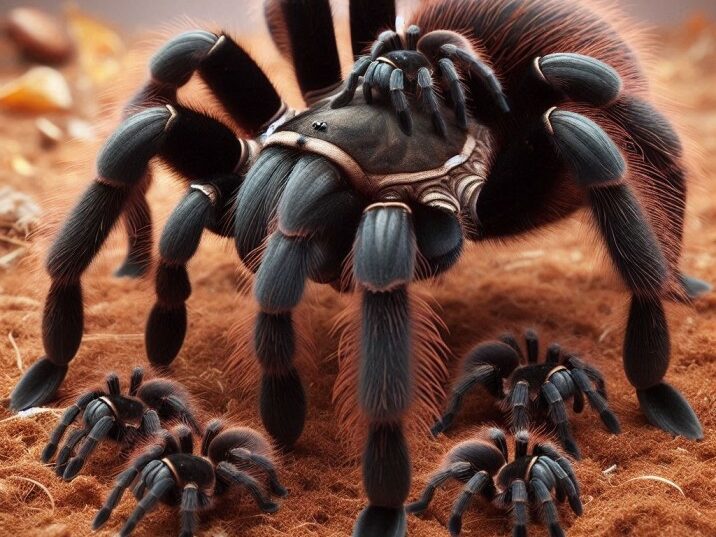Introduction
Table of Contents
Tarantulas are large, hairy spiders that belong to the family Theraphosidae. They are found in various parts of the world, including the Americas, Africa, Asia, and Australia. These spiders are known for their impressive size, unique appearance, and intriguing behaviors. One of the most interesting aspects of tarantulas is their reproduction process and the number of babies they can have. In this article, we will explore the fascinating world of tarantula reproduction and answer the question: How many babies tarantulas have?

The Life Cycle of a Tarantula
1. Egg Laying
Tarantulas lay eggs after a successful mating process. The female tarantula lays her eggs in a silk sac, which she carefully guards and protects. Depending on the species, a female tarantula can lay anywhere from 50 to 2,000 eggs at a time. This wide range in the number of eggs is influenced by factors such as the species of tarantula and environmental conditions.
2. Egg Sac and Incubation
The egg sac is a protective silk structure where the tarantula eggs are kept safe. The female tarantula meticulously tends to her egg sac, often rotating it to ensure even temperature and humidity. The incubation period for tarantula eggs can vary, typically ranging from 6 to 10 weeks. During this time, the mother tarantula remains vigilant, guarding her precious cargo from potential threats.
3. Hatching and Spiderlings
When the incubation period is over, the eggs hatch, and tiny baby tarantulas, known as spiderlings, emerge. These spiderlings are extremely small and delicate. Initially, they remain within the egg sac, where they continue to develop. After a short period, they venture out of the sac and begin to explore their surroundings.
How Many Babies Tarantulas Have?
The number of babies, or spiderlings, a tarantula can have depends on several factors, including the species of the tarantula and environmental conditions. Here are some examples of different tarantula species and the number of babies they typically have:
| Tarantula Species | Number of Babies |
|---|---|
| Mexican Red-knee Tarantula | 300 – 500 |
| Goliath Birdeater Tarantula | 100 – 200 |
| Chilean Rose Hair Tarantula | 200 – 800 |
| Cobalt Blue Tarantula | 100 – 150 |
| Pink Toe Tarantula | 50 – 200 |
These numbers are approximate and can vary depending on individual circumstances. However, it is clear that tarantulas can have a large number of babies, making their reproduction process quite remarkable.
Factors Influencing the Number of Babies
Our Question is how many babies tarantulas have? So to answer is this question, there are following factors which influence the number of babies of tarantulas.
1. Species of Tarantula
Different species of tarantulas have varying reproductive capacities. Some species, like the Goliath Birdeater, have fewer babies compared to others, such as the Mexican Red-knee Tarantula. The biological differences between species play a significant role in determining the number of eggs a female can lay.
2. Environmental Conditions
The environment in which a tarantula lives can also impact the number of babies it has. Factors such as temperature, humidity, and availability of food can influence the reproductive success of tarantulas. Optimal conditions can lead to a higher number of eggs and healthier spiderlings.
3. Age and Health of the Female
The age and health of the female tarantula are crucial factors in determining her reproductive capacity. Younger, healthier females are likely to produce more eggs compared to older or less healthy ones. Proper nutrition and care can enhance the reproductive success of female tarantulas.
The Journey of Spiderlings
1. Early Development
Once the spiderlings hatch, they go through several stages of development. Initially, they remain close to their mother and the egg sac. During this time, they rely on their mother’s protection and the nutrients from the egg sac to grow and develop.
2. Molting Process
As spiderlings grow, they undergo a process called molting, where they shed their exoskeleton to make way for a new, larger one. Molting is a critical part of a tarantula’s life cycle and occurs multiple times throughout its development. Each molt marks a significant growth stage for the spiderlings.
3. Independence
After several molts, the spiderlings become more independent and start to venture away from their mother. They begin to hunt for their own food and establish their territories. This period is crucial for their survival as they learn to fend for themselves in the wild.
Interesting Facts About Tarantula Babies
- Cannibalism: In some species, spiderlings may exhibit cannibalistic behavior, where stronger individuals prey on their weaker siblings. This behavior helps reduce competition for resources.
- Dispersal: After hatching, spiderlings often disperse to find their own habitats. This dispersal helps reduce competition and increases their chances of survival.
- Predation: Spiderlings face numerous predators, including birds, reptiles, and other spiders. Their small size and vulnerability make them easy targets.
Conclusion
Tarantulas are fascinating creatures with a unique reproductive process. The number of babies a tarantula can have varies depending on the species, environmental conditions, and the health of the female. Understanding the life cycle and development of tarantula spiderlings provides insight into the remarkable world of these arachnids. Whether it’s the Mexican Red-knee Tarantula with its 300-500 spiderlings or the Goliath Birdeater with 100-200, the journey of tarantula babies is truly captivating.
FAQs about How Many Babies Tarantulas have
1. How many eggs does a tarantula lay?
A tarantula can lay anywhere from 50 to 2,000 eggs depending on the species and environmental conditions.
2. How long does it take for tarantula eggs to hatch?
Tarantula eggs typically hatch after an incubation period of 6 to 10 weeks.
3. What are baby tarantulas called?
Baby tarantulas are called spiderlings.
4. Do tarantulas take care of their babies?
Yes, female tarantulas guard their egg sac and protect their spiderlings until they become more independent.
5. How often do tarantulas reproduce?
Tarantulas typically reproduce once a year, but this can vary depending on the species and environmental conditions.

